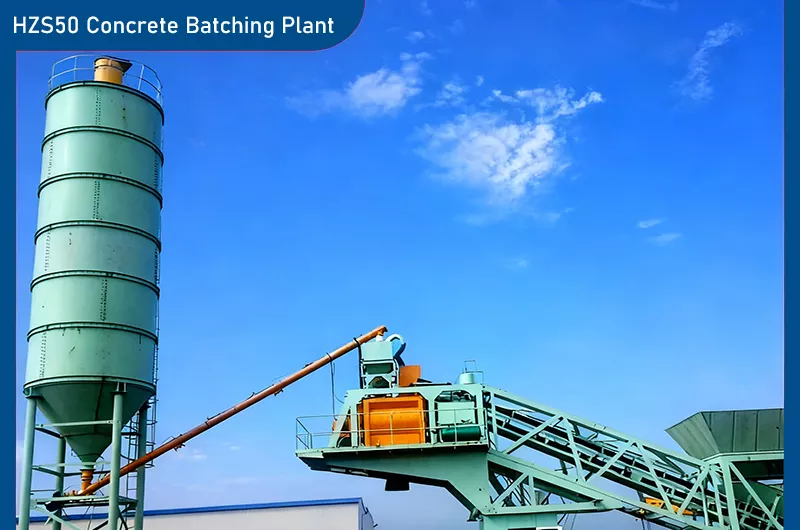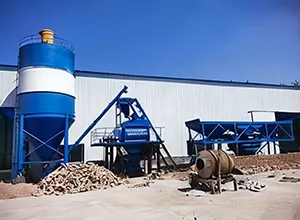HZS50 is a medium-sized concrete batching equipment with a theoretical production capacity of 50 cubic meters per hour. It is suitable for medium and small construction sites, precast component factories, and commercial concrete production plants. Its standard configuration usually includes a JS1000 twin-shaft compulsory mixer, a PLD1600 three-bin batching machine, cement silos, screw conveyors, and a computer control system.

The HZS50 concrete batching plant is a technologically mature, reliable, and cost-effective medium-sized concrete production equipment, making it an ideal choice for many construction units and commercial concrete enterprises.
Parameters of HZS50 Concrete Batching Plant
| Model | HZS50 | |
| Specification | Unit | Value |
| Productivity | m3/h | 50 |
| Capacity of Mixer | m3 | 1 |
| Mixer Power | kw | 37 |
| Discharge Height | m | 3.8(for customers choice) |
| Aggregate Bin | Quantity | 3 |
| Aggregate Bin Capacity | m3 | 1.6 |
| Max. Weighing Value of aggregate | kg | 3000 |
| Max. Weighing Value of cement | kg | 600 |
| Max. Weighing Value of water | kg | 400 |
| Max. Weighing Value of additive | kg | 50 |
| Aggregate Measuring Accuracy | % | 2 |
| Water Measuring Accuracy | % | 1 |
| Cement Measuring Accuracy | % | 1 |
| Additive Measuring Accuracy | % | 1 |
| Cement Silo | _ | Optional |
| Cement Screw Conveyor | _ | Optional |
| Cement Silo Capicity | _ | Optional |
| Control Mode | _ | Auto/Semi control |
HZS50 Concrete Batching Plant Components and Configuration
A complete HZS50 batching plant typically consists of the following systems:
Mixing System
- Core Component: One JS1000 twin-shaft compulsory concrete mixer. This is the “heart” of the batching plant, with a discharge capacity of 1 cubic meter per batch, and is therefore often referred to as a “1-cubic-meter mixer.”
- Features: High mixing efficiency, excellent mixing uniformity, suitable for all concrete grades (from low to high strength).
Material Batching System
- Usually consists of 3–4 aggregate bins (for sand and gravel) along with belt feeders or hopper elevators.
- Each bin is equipped with a weighing hopper and sensors to ensure accurate aggregate proportioning.
Material Conveying System
Aggregate conveying: Mainly in two forms:
- Belt Conveyor (mainstream option): Smooth conveying, high efficiency, low energy consumption, long service life—this is the preferred choice for modern HZS50 plants.
- Bucket Elevator: Small footprint but relatively lower efficiency and slightly more complex maintenance. More commonly seen in older or space-limited setups.
Powder conveying: Cement and fly ash are conveyed from the silos to the powder weighing hopper via screw conveyors.
Powder Storage System
- Typically equipped with 2–4 cement silos, with common capacities of 100 tons or 150 tons.
- Each silo is equipped with a dust collector on the top to prevent dust pollution.
Control System
This is the “brain” of the batching plant. Modern HZS50 plants generally adopt fully automatic computer control systems.
Functions: Can store multiple mix formulas, automatically control the entire process of feeding, weighing, mixing, and discharging, and record production data in real time with report printing capability.
Pneumatic System and Water Supply System
- Pneumatic system: Composed of an air compressor, cylinders, and solenoid valves. It operates the opening and closing of all material and discharge gates.
- Water supply system: Includes a water tank, water pump, water weighing hopper or flowmeter to precisely control water and admixture dosing.
HZS50 Concrete Batching Plant Features
Advantages:
- Moderate investment with high return: Compared with large batching plants, it has lower initial and operating costs, making it ideal for medium and small projects and commercial concrete suppliers.
- Small footprint: Compact structure with minimal land requirements, easy to install and relocate.
- Stable production efficiency: The hourly output of 50 m³ can meet the continuous concrete supply demands of most medium and small projects.
- High automation level: Easy operation, requiring only a small number of personnel to manage the entire production process.
- Environmental performance can be enhanced: Dust collection, wastewater recycling, and other environmental protection devices can be added to meet local environmental standards.
Disadvantages:
- Capacity limitations: For large projects (such as high-speed rail or dam construction) or high-demand commercial concrete markets, its output may become a bottleneck.
- Requires supporting equipment: Needs concrete mixer trucks to transport mixed concrete to construction sites.
HZS50 Concrete Batching Plant Applications
The HZS50 batching plant is truly a “multi-purpose” solution, widely used in:
- Medium and small construction projects: Such as residential buildings, factories, office buildings, etc.
- Road and bridge projects: For medium and small bridges, rural roads, and national road maintenance.
- Precast component factories: Producing concrete piles, concrete bricks, sleepers, and other precast elements.
- Water conservancy projects: Construction of small reservoirs and channel structures.
- Commercial concrete production: Serving county-level and city-level ready-mix concrete companies.
HZS50 Concrete Batching Plant Comparison with Other Models
HZS50 vs HZS60
- HZS50: Hopper lifting, compact structure, small footprint (200 m²), suitable for medium and small projects, lower price.
- HZS60: Belt conveyor, slightly higher output, more complex structure, larger footprint, suitable for medium-to-large projects.
Suitable Project Scale:
- Small projects (<35 m³/h): choose HZS25/HZS35
- Medium projects (35–75 m³/h): HZS50/HZS75 (recommended)
- Large projects (>75 m³/h): HZS90 and above
Recommendations for Purchasing an HZS50 Concrete Batching Plant
If you are considering purchasing an HZS50 batching plant, please note the following:
Key Selection Points:
- Based on project scale: Estimate total concrete demand and daily/hourly requirements.
- Based on site conditions: Available space and accessibility.
- Based on project duration: Choose a stationary plant for long-term fixed projects and a mobile plant for short-term or frequently relocated projects.
Clarify Configuration Requirements:
- Mixing host: JS1000 model (standard configuration)
- Batching machine: PLD1600 model; 3–4 bins recommended to improve batching efficiency.
- Cement silos: Recommend two 50-ton silos (more flexible than one 100-ton silo).
- Aggregate conveying method: Prefer belt conveying for higher efficiency.
- Control system: Prefer fully automatic systems with data management functions.
- Environmental requirements: If located in a region with strict environmental regulations, choose an enclosed/semi-enclosed plant equipped with dust collection and sand-gravel recycling systems.
The HZS50 concrete batching plant is a widely used medium-sized batching equipment in the construction industry, combining cost-effectiveness and practicality. Its modular design, efficient mixing, and accurate weighing make it an ideal choice for concrete supply in engineering projects. When selecting a plant, it is recommended to consider project scale, site conditions, and budget to choose the most suitable configuration and a reliable brand.
Haomei HZS50 Concrete Batching Plant Customer Cases
-
 Philippines HZS50 Concrete Batching Plant
Philippines HZS50 Concrete Batching Plant
-
 Indonesia HZS50 Concrete Batching Plant
Indonesia HZS50 Concrete Batching Plant
-
 HZS50 Concrete Batching Plant Pakistan
HZS50 Concrete Batching Plant Pakistan
-
 HZS50 Concrete Batching Plant Kazakhstan
HZS50 Concrete Batching Plant Kazakhstan
-
 JS1000 Mixer-Integrated HZS50 Concrete Batching Plant Operated in Argentina
JS1000 Mixer-Integrated HZS50 Concrete Batching Plant Operated in Argentina


